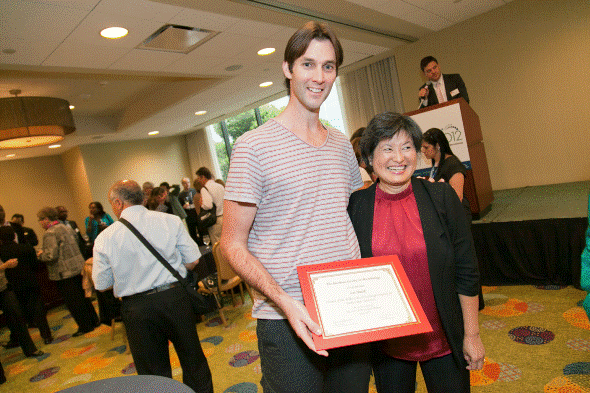Millis Colwell Award
Lee HudekMicrobiology Australia 33(4) 000-000 https://doi.org/10.1071/MA12902
Published: 1 November 2012

|
The notification of being the recipient of the 2012 Millis-Colwell Award was very welcomed to say the least. Having just completed my PhD, the opportunity to present my research on metal homeostasis mechanisms in the cyanobacterium Nostoc punctiforme at the world’s largest forum for microbiology was very exciting. The city hosting the 112th ASM general meeting was sunny San Francisco (until around 4pm when the fog rolled in). The International Reception on the Sunday night was a great social gathering, where I got to meet Jessie Mclean who did a brilliant job sorting out my conference registration and attendance, as well as the Chair of the International Board for the ASM Dr. May Chu, who presented my 2012 Millis-Colwell certificate.
The presentation I gave was on the final day of the conference, Tuesday 19th of June. It was fantastic to be able to promote my research titled “Cyanobacterial metal uptake mechanisms” to a broad group of microbiologists and have engaging conversations with a few researchers who I had been eager to meet including Prof. Michael Summers and his research group. By the end of the Tuesday my brain was as crammed with inspiring knowledge and all that was left to do was meet up with my host supervisor Prof. John “Jack” Meeks for our trip to Davis. Davis was home for the best part of two months, where I worked in the Meeks laboratory at UC Davis.
The Meeks lab members were very welcoming, giving me the opportunity to do a presentation as well as hanging my poster from the ASM conference in the lab. I was very fortunate to be given the opportunity to work in the Meeks lab, the vanguard of N. punctiforme research. The research I conducted during my time in the Meeks lab was microarray analyses to determine what genes are involved in the preferential uptake of zinc over cobalt in N. punctiforme. Whilst undertaking the microarray, much help was provided by everyone in the lab. I was fortunate to have Dr. Emiko Sano doing some array samples at the same time. As this was her first array we were able to run through the steps together, with the ever helpful Dr. Daniela Ferreira and Elsie Campbell guiding us through.
After the array was completed, I was able to get some first-hand experience doing tri-parental mating to transform N. punctiforme, as opposed to the electroporation method I typically use. I also was able to take advantage of having all the tools to establish over-expression constructs using specific plasmids for N. punctiforme. This will enable complementation in the knockout mutants that I had previously created.
Now back in Melbourne working in the lab at the Centre for Cellular and Molecular Biology, I am as enthusiastic as ever to continue my research on N. punctiforme using the newly acquired tools and techniques I brought back from the Meeks lab. I would like to thank the Australian Society for Microbiology for their continued support for my research and my Supervisors Prof Leigh Ackland, Prof Brett Neilan and Prof Jack Meeks. I would also like to thank Janetta Stones and Jessie Mclean for their help and support, the ASM Millis-Colwell committee and the Meeks lab at UC Davis.


